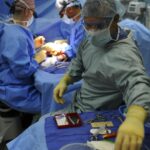The technological advancements in the field of modern medicine has helped revolutionize our approach towards healthcare especially in the sector of cardiac surgery. The cutting edge innovation of robotic cardiac surgery has led to transformation in the cardiovascular interventions which helps provide patients with minimally invasive procedures alternative to open heart surgery.
Multiple benefits offered by robotic cardiac surgery such as increased precision, faster recovery as well as better cosmetic outcomes makes this a promising advancement that revolutionized the approach towards cardiovascular procedures. Robotic cardiac surgery is paving the way for better outcomes and improved quality of life for patients around the world.
The mastery of robotic surgical techniques by the best robotic heart surgeons sets a new standard in cardiac surgery in India. It is important to understand the intricacies of robotic cardiac surgery, exploring its procedure, benefits, and the transformative impact it has on patient outcomes.
What is Robotic Cardiac Surgery?
Robot assisted cardiac surgery, also known as Robotic cardiac surgery, is a procedure used to perform intricate surgical procedures on the heart with the use of robotic systems. The traditional open heart surgery includes large incision and focuses on manual manipulation of the heart whereas through robotic surgery the use of miniature instruments with a HD camera on robotic arms helps achieve precise and controlled movements. The surgeon controls the arm in the confined space of the chest cavity with the help of a console that translates the hand movements to follow precise actions performed by the robotic instruments inside the patient’s body.
Understanding The Procedure For Robotic Heart Surgery
Prior to the surgery, the patient undergoes a comprehensive evaluation to assess their overall health and suitability for robotic cardiac surgery. This includes diagnostic tests such as imaging studies and cardiac catheterization to evaluate the condition of the heart and blood vessels.
- The patient is placed under general anesthesia to ensure they remain unconscious and pain-free throughout the procedure.
- Once the patient is prepared, the surgical team sets up the robotic system, including positioning the robotic arms and attaching the miniature surgical instruments.
- Instead of a large incision in the chest, robotic cardiac surgery typically involves several small incisions, known as keyhole incisions, through which the robotic instruments and camera are inserted into the chest cavity.
- Using the console, the surgeon manipulates the robotic arms to perform the necessary surgical tasks, such as repairing heart valves, removing blockages in the coronary arteries, or performing other intricate procedures.
- After the surgical procedure is completed, the incisions are closed with sutures or surgical glue, and the patient is transferred to the recovery area for monitoring.
Benefits of Robotic Cardiac Surgery
Minimally Invasive: One of the primary advantages of robotic cardiac surgery is its minimally invasive nature. By utilizing small incisions and precise robotic instruments, surgeons can access the heart with minimal trauma to the surrounding tissues, resulting in less pain, reduced risk of infection, and faster recovery times for patients.
Reduced Blood Loss: The minimally invasive nature of robotic cardiac surgery is associated with reduced blood loss during the procedure, leading to lower transfusion rates and decreased risk of postoperative complications such as anemia and infection.
Shorter Hospital Stay: Compared to traditional open-heart surgery, patients undergoing robotic cardiac surgery typically experience shorter hospital stays and faster recovery times, enabling them to return to their normal activities and quality of life sooner.
Enhanced Precision: With the robotic system provided to the surgeons an increased precision and maneuverability is ensured, This allows more precise surgical movements
and a greater access to hard to reach areas of the heart. This ensures better and more improved surgical outcomes while reducing the complication and ensuring better results long term.
Cosmetic Benefits: The small keyhole incisions used in robotic cardiac surgery result in less visible scarring and improved cosmetic outcomes compared to the large incision required for open-heart surgery, contributing to greater patient satisfaction and confidence.
Conditions Treated with Robotic Cardiac Surgery: This surgery can be used to treat a wide range of cardiovascular conditions, including:
- Mitral valve repair or replacement
- Atrial septal defect (ASD) closure
- Coronary artery bypass grafting (CABG)
- Atrial fibrillation (AFib) ablation
- Removal of cardiac tumors
- Repair of congenital heart defects
Things To Consider While Choosing The Best Cardiac Heart Surgeons
The integration of robotics into surgical practice has brought forth unparalleled precision, reduced invasiveness, and faster recovery times for patients. When it comes to choosing the best robotic heart surgeons , there are multiple factors that should be considered.
Credentials and Expertise: When entrusting someone with the most vital organ in your body, it’s imperative to verify their credentials thoroughly. A surgeon who has performed a high volume of surgeries is likely to have mastered their skills and encountered a diverse range of cases, thereby enhancing their proficiency.
Hospital Reputation and Resources: The reputation and resources of the hospital where the surgeon operates play a pivotal role in ensuring a successful surgical outcome. Hospitals with robust cardiac surgery programs often have better infrastructure, post-operative care protocols, and lower rates of complications.
Patient Testimonials and Referrals: Seek out testimonials and referrals from previous patients who have undergone robotic heart surgery with the surgeon in question. Additionally, don’t hesitate to ask your primary care physician or cardiologist for recommendations—they can provide trusted referrals based on their knowledge of your medical history and individual needs.
Research and Innovation: A top-notch robotic heart surgeon is committed to continuous learning and staying abreast of the latest advancements in their field. Inquire about the surgeon’s involvement in clinical research, publication of scholarly articles, and participation in conferences or professional associations.
Communication and Empathy: Effective communication between the surgeon and patient is essential for fostering trust and understanding throughout the treatment journey. Empathy and compassion are equally important traits—choose a surgeon who demonstrates genuine care for your well-being and emotional support for you and your family members.
Surgical Approach and Track Record: Each robotic heart surgeon may have a preferred approach to cardiac surgery, whether it’s minimally invasive valve repair, coronary artery bypass grafting, or atrial fibrillation treatment. Discuss the surgeon’s specific techniques and inquire about their success rates and complication rates for the procedure you require. A surgeon with a track record of excellent outcomes and low complication rates instills confidence and peace of mind in their patients.
Accessibility and Availability: Accessibility and availability are crucial factors to consider, especially in emergencies or urgent situations. Ensure that the surgeon you choose is readily accessible for consultations, follow-up appointments, and any unforeseen complications that may arise post-surgery. A responsive and accessible surgeon provides reassurance and support throughout the entire treatment process, from pre-operative preparation to post-operative recovery.
Insurance Coverage and Financial Considerations: Robotic heart surgery can be a significant financial investment, so it’s essential to understand your insurance coverage and any out-of-pocket expenses associated with the procedure. Verify that the surgeon and hospital are in-network providers with your insurance plan, and inquire about financing options or payment plans if needed.
Trust Dr Udgeath Dhir, The Best Robotic Heart Surgeon For Expert Cardiac Care
When it comes to choosing the best robotic heart surgeons various factors are considered such as credentials, expertise, reputation of the hospital as well as testimonials of the patients and many more. The procedure of robotic cardiac surgery offers patients an alternative to the traditional heart surgery by being a safer and more precise option.
Experience the future of cardiac surgery with our state-of-the-art minimally invasive robotic procedures. Our skilled team, led by the best cardiac surgeon in Gurugram, India, Dr. Udgeath Dhir, harnesses the power of advanced robotic technology to provide you with safer, more precise, and less invasive options for your heart health journey.
Dr.Udgeath Dhir is committed to providing you with the most advanced, patient-centered care available. Schedule a consultation with the best cardiac surgeon in Gurugram Dr. Udgeath Dhir today. Remember, your heart is in capable hands when you choose a skilled and compassionate robotic heart surgeon dedicated to delivering the highest standard of care.




